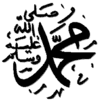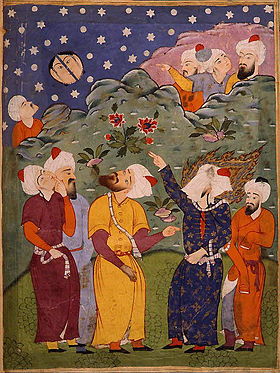- Splitting of the moon
-
The splitting of the moon (Arabic: انشقاق القمر) was a miracle performed by Muhammad in Islamic tradition.[1] The incident is mentioned in Muslim traditions as the context of revelation (asbāb an-nuzūl) for the Qur'anic verse 54:1-2 where some Muslim commentators accept the historicity of the miracle and some reject it.[citation needed].
Early traditions supporting a literal interpretation are transmitted on the authority of companions of Muhammad such as Ibn Abbas, Anas bin Malik, Abdullah bin Masud and others.[2][3] According to the Indian Muslim scholar Yusuf Ali, the moon might split again when the day of judgment approaches. He says that the verse may also have an allegorical meaning, i.e. the matter has become clear as the moon.[4][5] The Qur'anic verse 54:1-2 was part of the debate between medieval Muslim theologians and Muslim philosophers over the issue of the inviolability of heavenly bodies. Philosophers held that the heavenly bodies could not be pierced because unlike the terrestrial matter, they were not composed of the four fundamental elements of earth, air, fire, and water.[6] Some other rationalistic Muslim thinkers had difficulties accepting any preternatural event, and sometimes argued that only an appearance of the split of the moon had happened.[7]
Western historians such as A.J. Wensinck and Denis Gril, reject the historicity of the miracle arguing that the Qur'an itself denies miracles, in their traditional sense, in connection with Muhammad.[8][9]
The narrative was used by some later Muslims to convince others of the prophethood of Muhammad.[7] It has also inspired many Muslim poets, especially in India.[8]
Contents
The Qur'an and Islamic tradition
Verse 54:1-2 of the Qur'an reads:
The hour drew nigh and the moon did rend asunder. And if they see a miracle they turn aside and say: Transient magic.
There are many who believe that these verses show that moon will split in twain when hour of last day comes to pass. And Muhammad never performed such miracle.[10]
And there are many early traditions and stories that explain the above verse as a miracle performed by God during the life of Muhammad in order to convince Quraysh of his prophethood.[11][12] Virtually all Muslim commentators accept the authenticity of those traditions. The following verse 54:2, "But if they see a Sign, they turn away, and say, 'This is (but) transient magic'" is taken in the support of this view.[12] The classical commentator Ibn Kathir provides a list of the early traditions mentioning the incident: A tradition transmitted on the authority of Anas bin Malik states that Muhammad split the moon after the pagan Meccans asked for a miracle. Another tradition from Malik transmitted through other chains of narrations, mentions that the mount Hira was visible between the two parts of the moon (Mount Hira is located in Hijaz. Muslims believe that Muhammad received his first revelations from God in a cave on this mountain). A tradition narrated on the authority of Jubayr ibn Mut'im with a single chain of transmission says that the two parts of the moon stood on two mountains. This tradition further states that the Meccan responded by saying "Muhammad has taken us by his magic...If he was able to take us by magic, he will not be able to do so with all people." Traditions transmitted on the authority of Ibn Abbas briefly mention the incident and do not provide much details.[2] Traditions transmitted on the authority of Abdullah bin Masud describe the incident as follows:[2][13]
We were along with God's Messenger at Mina, that moon was split up into two. One of its parts was behind the mountain and the other one was on this side of the mountain. God's Messenger said to us: Bear witness to this 039:6725
Al-Zamakhshari, a famous commentator of the Qur'an, acknowledged the splitting of the moon as one of Muhammad's miracles. But he also suggested that the splitting might take place only on the day of judgment.[6] The Muslim scholar Yusuf Ali provides three different interpretations of the verse. He holds that perhaps all three are applicable to the verse: Moon once appeared cleft asunder at the time of Muhammad in order to convince the unbelievers. It will split again when the day of judgment approaches (here the prophetic past tense is taken to indicate the future). Yusuf Ali connects this incident with the disruption of the solar system mentioned in 75:8-9. Lastly, he says that the verses can be metaphorical, meaning that the matter has become clear as the moon.[14]
Dissenting commentators who do not accept the miracle narration such as Hasan al-Basri (d. 110 H.) and 'Ata al-Khurasani (d. 135 H.) believe that the verse only refers to the splitting of the moon at the day of judgment.[12][15][7] Likewise, M. A. S. Abdel Haleem writes:
The Arabic uses the past tense, as if that Day were already here, to help the reader/listener imagine how it will be. Some traditional commentators hold the view that this describes an actual event at the time of the Prophet, but it clearly refers to the end of the world. [16]
Some other Muslim thinkers had difficulties accepting this event and other preternatural events and, according to Annemarie Schimmel, sometimes tried to "de-mythologize" it.[7][6] For example, Shah Waliullah of Delhi (d. 1762) said that the event "may have been a kind of hallucination, or perhaps caused by a smoke, by the swooping down of a star, a cloud, or an eclipse of the sun or the moon which might be given the impression that the moon was actually split in two."[7]
In later Islam
A series of articles on

Prophet of Islam
Muhammad
Life
In Mecca · Hijra · In Medina · Conquest of Mecca · Wives · Farewell pilgrimage · Family tree ·
Career
Qur'an · Hadith ·
Early reforms under Islam · Diplomacy · Military · Persecution by Meccans · Migration to Abyssinia ·
Miracles
Isra and Mi'raj · Relics · Splitting of the moon ·
Al-Masjid al-Nabawi ·
Views by subject
Jewish · Christian · Slavery ·
Succession
Farewell sermon · Saqifah · Pen and paper · Family · Companions · History ·
Praise
Durood · Na'at · Mawlid · Haḍra · Madih nabawi ·
Ya Muhammad ·
Perspectives
Islamic · Jewish · Bible · Medieval Christian · Historicity · Criticism · Prophetic biography · Depictions · Films · Depictions in film ·The narrative was used by some later Muslims to convince others of the prophethood of Muhammad. Annemarie Schimmel for example quotes the following from Muslim scholar Qadi Iyad who lived in Ceuta in Spain:[7]
It has not been said of any people on the earth that the moon was observed that night such that it could be stated that it was not split. Even if this had been reported from many different places, so that one would have to exclude the possibility that all agreed upon a lie, yet, we would not accept this as proof to the contrary, for the moon is not seen in the same way by different people.... An eclipse is visible in one country but not in the other one; in one place it is total, in the other one only partial.
Debate over the inviolability of heavenly bodies
The Qur'anic verse 54:1-2 was part of the debate between medieval Muslim theologians and Muslims philosophers over the issue of the inviolability of heavenly bodies. The philosophers held that nature was composed of four fundamental elements: earth, air, fire, and water. Philosophers however held that the composition of heavenly bodies were different. This belief was based on the observation that the motion of heavenly bodies, unlike that of terrestrial bodies, was circular and without any beginnings or ends. This appearance of eternity in the heavenly bodies, led the philosophers to conclude that the heavens were inviolable. Theologians on the other hand proposed their own conception of the terrestrial matter: the nature was composed of uniform atoms that were re-created at every instant by God (the latter idea was added to defend God's omnipotence against the encroachment of the independent secondary causes). According to this conception, the heavenly bodies were essentially the same as the terrestrial bodies, and thus could be pierced.[6]
In order to deal with implication of the traditional understanding of the Qur'anic verse 54:1-2, philosophers argued that the verse should be interpreted metaphorically (e.g. the verse could have referred to a partial lunar eclipse in which then earth obscured part of the moon).[6]
Literature
This tradition has inspired many Muslim poets, especially in India.[8] In poetical language Muhammad is sometimes equated with the sun or the morning light. As such, part of a poem from Sana'i, a renowned early twelfth century Persian Sufi poet, reads: "the sun should split the moon in two".[7] Jalal ad-Din Rumi, a renowned Persian-writing poet and mystic, in one of his poems conveys the idea that to be split by the Muhammad's finger is the greatest bliss the lowly moon can hope for and a devoted believers splits the moon with Muhammad's finger.[7] Elaborating on this idea, Abd ar-Rahman Jami, one of the classical poets and mystics of Persia, plays with the shapes and numerical values of Arabic letters in a complicated way: The full moon, Jami says, resembles the Arabic letter for a circular m with the numerical value 40. When Muhammad split the moon, it became like two crescent-shaped n's (the Arabic letter for "n") whose numerical value is 50 each. This would mean that, thanks for the miracle, the value of moon had increased.[7]
In another place Rumi, according to Schimmel, alludes to two miracles attributed to Muhammad in tradition, i.e. the splitting of the moon (which shows the futility of man's scientific approach to nature), and the other that Muhammad being an illiterate:[7]
See also
- Islamic view of miracles
- Islamic view of Moses, for the miracle of splitting the Sea, retold in the Qur'an
- Muhammad before Medina
References
- ^ "Muhammad." Encyclopedia Britannica. 2007. Encyclopedia Britannica Online, p.13
- ^ a b c Ibn Kathir, Tafsir ibn Kathir, Sura Qamar, verse 54:1-2
- ^ "According to al-Tabari, all the expositors (ahl al-ta'wil) agree on essentially this same account for the occasion for the revelation of these verses." cf. Thomas E. Burman, Religious Polemic and the Intellectual History of the Mozarabs, C.1050-1200, p.150
- ^ Annemarie Schimmel, And Muhammad Is His Messenger: The Veneration of the Prophet in Islamic Piety, University of North Carolina Press, 1985, p.69–70
- ^ Robert G. Mourison, The Portrayal of Nature in a Medieval Qur’an Commentary, Studia Islamica, 2002
- ^ a b c d e Robert G. Mourison, The Portrayal of Nature in a Medieval Qur’an Commentary, Studia Islamica, 2002
- ^ a b c d e f g h i j Annemarie Schimmel, And Muhammad Is His Messenger: The Veneration of the Prophet in Islamic Piety, University of North Carolina Press, 1985, p.69–70
- ^ a b c Wensinck, A.J. "Muʿd̲j̲iza." Encyclopaedia of Islam. Edited by: P. Bearman , Th. Bianquis , C.E. Bosworth , E. van Donzel and W.P. Heinrichs. Brill, 2007.
- ^ Denis Gril, Miracles, Encyclopedia of the Qur'an, Brill, 2007.
- ^ Verse 54:1-2 of the Qur'an
- ^ See for example, Bukhari (5:28:208-211), Bukhari (4:56:830-832), Bukhari (6:60:345), Bukhari (6:60:349f.), Bukhari (6:60:387-391), Muslim (39:6721), Muslim (39:6724-6726), Muslim (39:6728-6730)
- ^ a b c Allameh Tabatabaei, Tafsir al-Mizan, Verse 54:1-2
- ^ Sahih Muslim, The Book Giving Description of the Day of Judgement, Paradise and Hell, Book 039, Number 6725
- ^ Yusuf Ali, Meaning of The Noble Qur’an, Sura 54, v.1
- ^ Majma Ul-Bayan
- ^ M. A. S. Abdel Haleem: The Qur'an, a new translation, note to 54:1
Categories:- Miracles attributed to Muhammad
Wikimedia Foundation. 2010.

